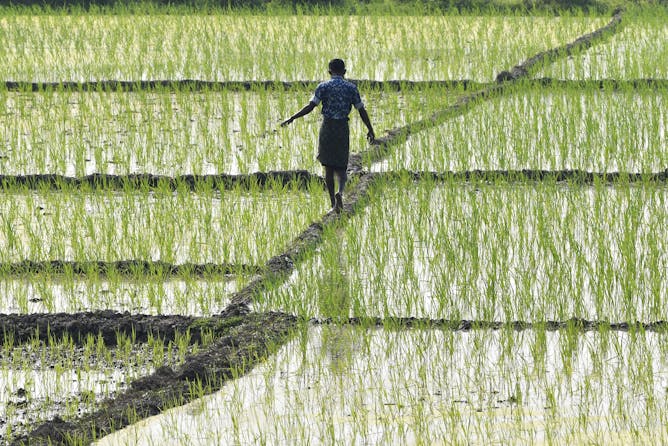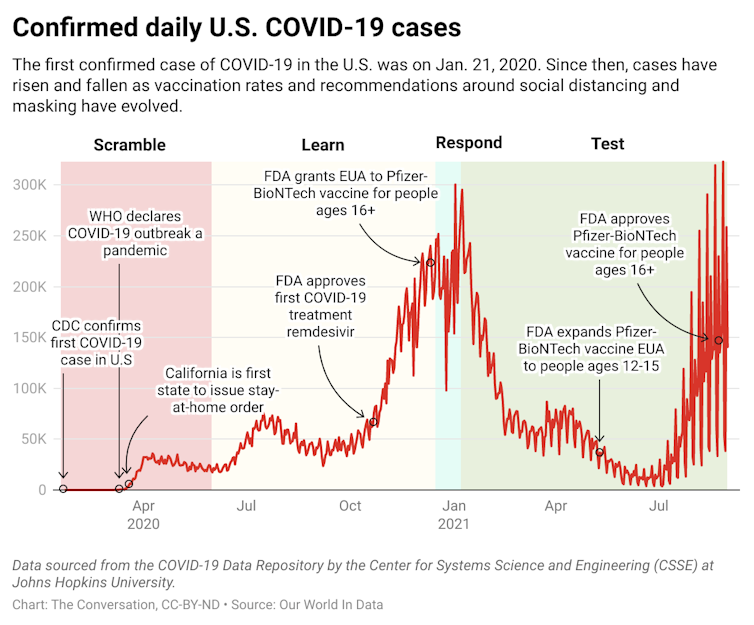|
When you think about what’s driving climate change, do you picture smokestacks and auto tailpipes? Well, you should also be visualizing farms and fields.
A new study from atmospheric scientists Xiaoming Xu and Atul Jain shines a light on the role of food production in global warming. The two scholars combined modeling and databases to create a tool for estimating greenhouse gas emissions from every phase of food production – from planting crops to managing livestock manure. They found that food production accounts for over one-third of human-made greenhouse gas emissions and spotlight some of the biggest contributors, such as beef and rice. Their research could provide valuable insights on how to target policy toward lower-carbon farming practices and diets.
Also today: America’s patchwork of COVID-19 vaccine mandates explained How much can you trust Big Tech? Psst … want to invest in a Picasso? How about a Banksy?
|

|
Jennifer Weeks
Senior Environment + Energy Editor
|
|

A farmer walks through a rice paddy in India’s northeastern state of Assam.
Buu Boro /AFP via Getty Images
Xiaoming Xu, University of Illinois at Urbana-Champaign; Atul Jain, University of Illinois at Urbana-Champaign
A new study provides a detailed way to calculate the climate impact of food production, which could lead to more sustainable farming policies and methods.
|
Economy + Business
|
-
Debbie Kaminer, Baruch College, CUNY
Overlapping vaccine mandates at the federal, state and local levels aims to reduce the number of unvaccinated Americans.
|
|
Environment + Energy
|
-
Kate T. Luong, George Mason University; Ed Maibach, George Mason University; John Kotcher, George Mason University
Pew asked people in 17 countries how they felt about climate change. The survey found some optimism but also deep ideological divides, particularly in the United States.
|
|
Politics + Society
|
-
Shelley Inglis, University of Dayton
The dangerous situation faced by Afghans who want to flee, but can’t, shows how unwilling or unprepared the US and other countries are to deal with refugees.
|
|
Ethics + Religion
|
-
Michael Vicente Perez, University of Memphis; Matthew Ingalls, American University in Dubai
Two scholars – both converts to Islam – set out to understand the Muslim community in Chile. Here is what they found.
|
|
Education
|
-
Lindsay Fernández-Rhodes, Penn State
Mexican Americans who have more formal education than their parents are much less likely to have Type 2 diabetes, new research finds.
-
Barnett Berry, University of South Carolina
Microschools might be an attractive alternative to regular public schools that are wrestling with the pandemic, but they are mostly out of reach for low-income students, a researcher says.
|
|
Arts + Culture
|
-
Kathryn Graddy, Brandeis University
Art is a risky investment, with estimated long-run returns, on average, below stocks. But investing in artworks may provide diversification to an investment portfolio, as well as enjoyment.
|
|
Science + Technology
|
-
Laurin Weissinger, Tufts University
Big Tech makes a lot of promises about protecting privacy, but the reality is that using the industry’s products is a matter of trust.
|
|
From our international editions
|
-
Ben Egliston, Queensland University of Technology; Marcus Carter, University of Sydney
Facebook is adamant its new “smart glasses” won’t be a privacy nightmare. But it is clearly bidding to normalise the use of wearable tech. And if video Ray-Bans go mainstream, what comes next?
-
Weeda Mehran, University of Exeter
Segregation and other measures being introduced by the Taliban’s hardline new government are being greeted with widespread protests, many of them led by women.
-
John Nauright, Mount Saint Mary College; Sarah Zipp, University of Stirling
The NBA Africa is making a play for expansion. Where does Barack Obama fit in?
Today’s graphic

From the story, 18 months of the COVID-19 pandemic – a retrospective in 7 charts
|
|
| |
| |
| |
| |
| |
| |
|
|